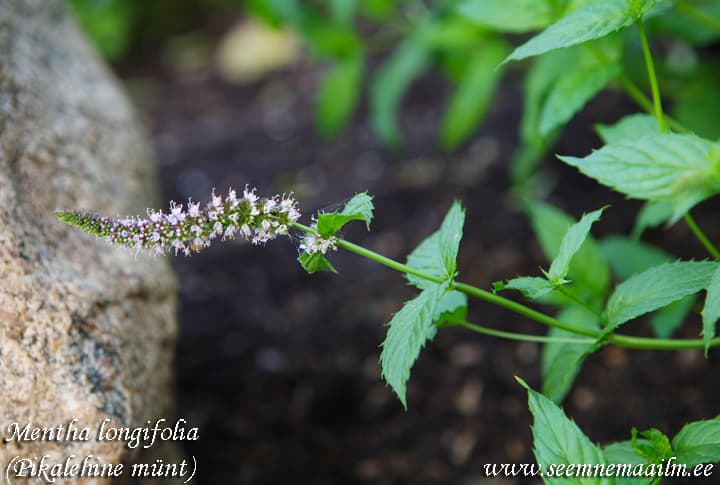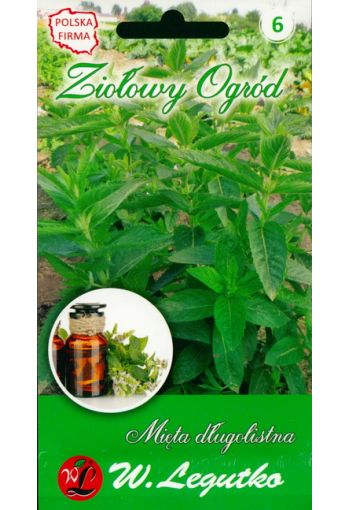Officinal (medicinal) plant; honey-bee food plants; beneficial plant.
VI-X.
Z5-8.
50 cm.
Light blue.
Perennial herb. Creeping rhizomes, located horizontally in the soil at a depth of 10-15 cm. Stems 110-140 cm high, branched, well-leafy, tetrahedral, erect.
Leaves sessile or with short petioles, ovate-lanceolate, up to 15 cm long and 2-3.5 cm wide, serrate-toothed along the edge, densely pubescent with soft hairs.
The flowers are small, pinkish-lilac or purple, collected in whorled racemose inflorescences. The fruit consists of 4 brown nuts.

Mentha longifolia.
Perennial herbaceous plant. Rhizomes creeping, located in the soil horizontally at a depth of 10-15 cm.
Stems 110-140 cm high, branched, well leafy, tetrahedral, erect.
Leaves sessile or with short petioles, ovate-lanceolate, up to 15 cm long and 2-3.5 cm wide, serrate-toothed along the edge, densely pubescent with soft hairs.
The flowers are small, pinkish-lilac or purple, collected in whorled racemose inflorescences. The fruit consists of 4 brown nuts.
Widely distributed in the wild. It occurs along the damp and wet banks of rivers and lakes, along the edges of swamps and ditches in Europe, Western Siberia, Asia Minor and the Caucasus.
Silver mint leaves contain up to 2.8% essential oil and vitamin C, as well as organic acids, tannins, flavonoids and other biologically active substances. Essential oil is used in medicine.
Longleaf mint should be grown on light, sufficiently moist and nutrient-rich soils.
Plants are placed in an open sunny area since with a lack of light, the lower leaves of plants crumble early and the total content of essential oil decreases.
Wild mint is propagated by segments of rhizomes and seeds:
- sowing seeds is carried out before winter to a depth of 1.5-2 cm.
- spring planting of rhizomes begins early when the soil is still saturated with moisture (first half of May) and autumn planting is carried out in late August - early September.
The planting method is wide-row: with distances between rhizomes in a row of 10-20 cm and 50-70 cm between rows with a deepening of rhizomes by 8-10 cm.
Leaves are harvested from the moment of regrowth until the appearance of buds.
Uses of Mentha longifolia in garden design:
* tall, densely leafy, grayish from dense pubescence, the bushes of this mint retain their decorative effect throughout the season (it is especially pretty during the dissolution of large racemose inflorescences with lilac-purple flowers)
* can be used for single and group landings
* for creating high green borders, in fragrant gardens and apothecary gardens
* for registration of crude coast of both large, and small reservoirs;
* attracts butterflies and bees
* contains a natural insecticide - pulegone, which repels pests (a good neighbour to tomatoes and cabbage).
Eng.: Silver mint, biblical mint, horsemint, wild mint. Bot. syn.: Mentha sylvestris L.
Medicinal properties of Mentha longifolia: raw materials are leaves harvested during the flowering period (June-August).
Fresh and dried, they are used as a spice, tea flavouring and culinary products.
Used as a home remedy containing: mono- and sesquiterpenoids, triterpenoids, steroids, phenols and their derivatives, phenolcarboxylic acids, chromones, flavonoids, anthocyanins, nitrogen-containing compounds, ascorbic acid, higher fatty acids, fatty oil, essential oil (in inflorescences - up to 4.6%).
Action: antimicrobial, fungistatic, antihelminthic, analgesic, antispasmodic, muscle relaxant, antioxidant, antiemetic, neuroprotective, antidiarrheal, carminative.
Diseases: gastric diseases, diarrhea, colic, nausea, migraines, rheumatism, neuralgia.











